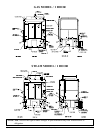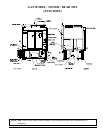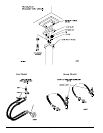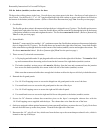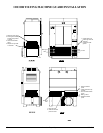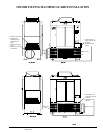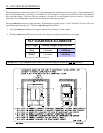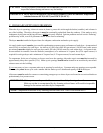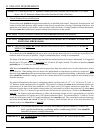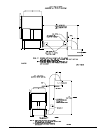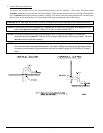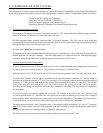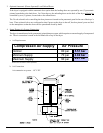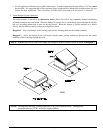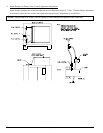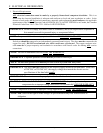
20 American Dryer Corp. 113217-5
D. EXHAUST REQUIREMENTS
NOTE: For 1 door dryers, the 24” diameter exhaust duct exits from the rear of the base. For 2 door
dryers, the 24” diameter exhaust duct exits from the left side of the base.
1. General Exhaust Ductwork Information
Exhaust ductwork should be designed and installed by a qualified professional. Improperly sized ductwork will
create excessive back pressure, which results in slow drying, increased use of energy, overheating of the dryer, and
shutdown of the burner by the airflow (sail) switches, burner hi-limits, or basket (tumbler) hi-limit thermostats.
The dryer must be installed with a proper exhaust duct connection to the outside.
CAUTION: This dryer produces combustible lint and must be exhausted to the outdoors.
CAUTION: IMPROPERLY SIZED OR INSTALLED EXHAUST DUCTWORK CAN CREATE A
POTENTIAL FIRE HAZARD.
NOTE: THE DRYER MUST BE INDEPENDENTLY EXHAUSTED. COMMON DUCTWORK IS
NOT ACCEPTABLE.
The exhaust ductwork should be laid out in such a way that the ductwork travels as directly as possible to the
outdoors with as few turns as possible. Single or independent dryer venting is recommended.
The shape of the ductwork is not critical provided that the minimum cross section area is maintained. It is suggested
that the use of 90º turns in ducting be avoided; use 30º and/or 45º angles instead. The radius of the elbow should
preferably be 1-1/2 times the diameter of the duct.
ALL ductwork should be smooth inside with no projections from sheet metal screws or other obstructions, which
will collect lint. When adding ducts, the ducts to be added should overlap the duct to which it is connected. ALL
ductwork joints must be taped to prevent moisture and lint from escaping into the building. Additionally, inspection
doors should be installed at strategic points in the exhaust ductwork for periodic inspection and cleaning of lint
from the ductwork.
The internal dimensions of the dryer’s rectangular exhaust vent ductwork is 8-1/2” x 21” (20.6 cm x 53.5 cm). A
24” diameter round transition piece is supplied. The location’s exhaust duct must be the minimum exhaust size
requirement of 24-inch (60.96 cm) round duct or 452 square inch (2,916 square centimeters) square duct. The
ductwork from the dryer to the outside exhaust outlet for a horizontal run with no more than one (1) elbow must
not exceed 43 feet (13.1 meters) for gas and 20 feet (6.09 meters) for steam dryers. (Refer to the illustration on
page 21.) For locations with more than one (1) elbow, the minimum exhaust size for a gas model dryer is 28-inch
(71.12 cm) round duct (615 square inch [3,967 square centimeters] duct). For a steam model, a 32-inch (81.28 cm)
round duct (840 square inch [5,419 square centimeters] duct) must be used. The vertical duct total run on both gas
and steam models must not exceed 50 feet (15.24 meters), which includes the use of no more than three (3)
elbows (refer to the illustration on page 21).
IMPORTANT: For extended ductwork runs or where more than the specified number of elbows are
used, a professional heating, ventilating, and air-conditioning (HVAC) firm should be
consulted for proper venting information.
IMPORTANT: It is recommended that exhaust or booster fans NOT BE USED in the exhaust
ductwork system.



